4th Convalescent Hospital Unit History
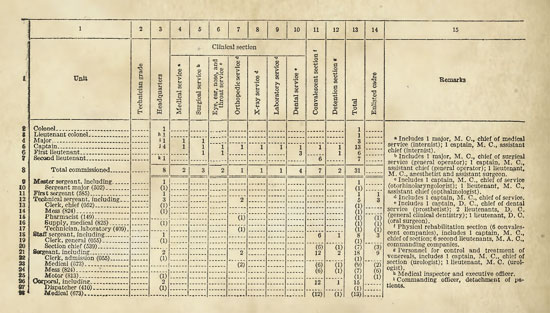
Partial document illustrating T/O 8-590, dated 1 April 1942, listing 31 Commissioned Officers and 192 Enlisted Men. Vehicles were limited to 4 3/4-ton Ambulances, 1 5-Passenger Light Sedan Car, 2 1/4-ton Trucks, 7 3/4-ton Weapon Carriers, and 4 2 1/2-ton Cargo Trucks (the previous T/O 8-233 dated 1941 indicated a total of 28 Officers & 189 EM).
Introduction and Activation:
In accordance with Military Orders, the 4th Convalescent Hospital was activated at Cp. McPherson, Atlanta, Georgia (Reception & Classification Center –ed), on 25 January 1943, with Lt. Colonel Edward S. Murphy, MC, in command.
The necessary cadre was furnished by the 3d Convalescent Hospital, and filter replacements and personnel came from Cp. Pickett, Blackstone, Virginia (Division Camp & Medical Replacement Training Center –ed), and Cp. Joseph T. Robinson, Little Rock, Arkansas (Infantry + Medical Replacement Training Center –ed), with MAC Officers provided out of Cp. Barkeley, Abilene, Texas (Armored Division Camp + Medical Replacement Training Center –ed). Lt. Colonel John W. Claiborne, Jr., MC assumed command on 25 May 1943 as Lt. Colonel E. S. Murphy was transferred to the Office of the Surgeon General.

Left: Partial view of prefab hutments (set up in Company Street) used for personnel barracks in Camp McPherson, Atlanta, Georgia. This is the Reception Center where the 4th Convalescent Hospital was activated on 25 January 1943.
Right: Partial view of pyramidal tents used to house additional personnel while training at the Reception Center. Both pictures taken in 1943. The organization spent most of its time at the Camp (January – September 1943) while stationed in the Zone of Interior.
The cadre consisted of 1 Medical Corps Officer and 37 Enlisted Men from the 3d Conv Hosp, Cp. Livingston, Alexandra, Louisiana (Army Ground Forces Training Station –ed). The unit was subsequently enlarged to T/O strength by EM sent from MRTCs at Cp. Pickett and Cp. J. T. Robinson, respectively. The required MAC Officers only joined the unit early in February 1943, having been trained and commissioned at MRTC Cp. Barkeley in Texas.
In general, the professional MC Officers did not join the unit until the week prior to departure of the 4th for its Staging Area which took place in September of 1943. No Nurses were assigned to the Hospital.

Left: Picture of Captain James Howell, MC, taken while the Hospital was stationed at Camp McPherson, ZI, between January and September 1943. Right: Picture of Private First Class Ralph K. Sellers, at the Motor Pool, Camp McPherson, ZI.
Training:
The 4th Convalescent Hospital at once entered into a rigid training program with the focus on a brief review of MTP 8-1, supplemented by portions of MTP 8-10 as pertinent in keeping with the proficiency in Military Training demonstrated by Enlisted members of the organization.
All Commissioned and Enlisted positions were filled in accordance with T/O 8-590, dated 1 April 1942 (aggregate personnel strength: 31 Officers & 192 EM –ed), and a strict doctrine was laid down as to the absolute minimum in deviation from such subscribed table, with the policy of the unit’s CO being followed in all cases. Military personnel were in general fit for field duties and capable of absorbing the most rigid types of training, but in general were weak in military or in medical matters and this necessitated a constant supervision with constructive criticism of delegated duties, but all personnel were always ready and willing to learn. Neither Nurses nor civilian personnel were included in the organization during the training period in the Zone of Interior. The absence of female Nurses somewhat simplified training matters from a pure military stand point, but made training of Enlisted Technicians the more necessary and at the same time more difficult (the professional jump from a Medical Officer to an Enlisted Technician was too great)!

Some general aspects of training.
Top left: Reception: new men are being marched to the Recruit Reception Center barracks.
Top right: Recruits air their beds in anticipation of their first night in camp.
Bottom: Trainees are jumping ditches. Physicial development and conditioning are some of the most important aspects of training.
Being activated at a relatively small (but permanent) Army Post, the unit’s training was greatly simplified (everyone was most cooperative). Immediately, a number of EM were placed in the Station Hospital, and other Sections throughout the Post. Equipment, literature, and training aids were in general adequate, however, one big deficiency was the lack of Mess facilities, but this was soon corrected in agreement with the Post Commander.
Medical and Quartermaster unit assemblages were not received due to lack of storage facilities. However, training equipment, supplies, and limited transportation were adequate and when the unit departed from the Zone of Interior, it received the minimum essential TAT (To Accompany Troops –ed) equipment.
While in the United States, housing was always adequate and consisted of frame or stone buildings, with tentage for Enlisted personnel. Potable water supplies were always available, as were bathing and laundry facilities. The field ration was used at all times; sewage and waste disposal took place through fixed installations; and field sanitation was stressed at every opportunity. Mosquitoes and flies offered some problems but were rapidly controlled. The VD-rate was low, with chemical prophylaxis and individual pro-kits available, and lectures and training films constantly in use.
In the United States, the 4th was never on an actual maneuver with other units, but daily road marches, weekly bivouacs, with preparation and use of all field sanitary appliances were constantly enforced. The 4th Convalescent Hospital never performed the mission of unit hospitalization, but without delay following arrival in ETOUSA (European Theater of Operations, United States Army –ed) the operation of a small Army Hospital was inaugurated for hospitalization of patients from a General Hospital awaiting evacuation to the Zone of Interior.
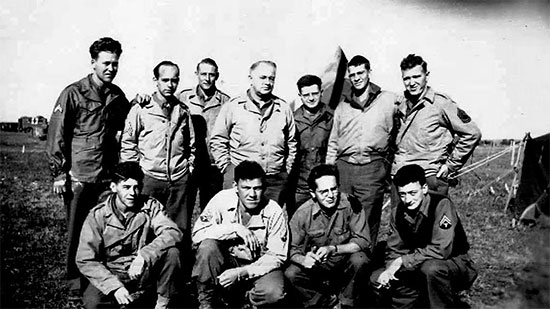
Group picture of 4th Convalescent Hospital personnel while training at Camp McPherson, Atlanta, Georgia. The Reception Center had an overall acreage of 371 and a capacity for 335 Officers and 5,917 Enlisted Men. Captain D. Waller (fourth from L back row) surrounded with the following Enlisted personnel; Vernon Nolte, Wappler, Burkeen, Bryson, Ralph K. Sellers, Jim Durbin, Gerrit Van Noorloos, Powell, Francis Felke, and Armstrong. Picture taken some time in 1943.
Preparation for Overseas Movement:
The most difficult situation that confronted the organization during its training period in the States was the elimination of Limited Service Enlisted Men unfit for overseas service. Moreover, the necessary replacement of MC Officers which just took place prior to departure for Cp. Kilmer, Stelton, New Jersey (Staging Area for New York Port of Embarkation –ed), caused another difficulty. Some of the Officers hardly met the minimum requirements for professional standards, but very little could be corrected in the period of time remaining.
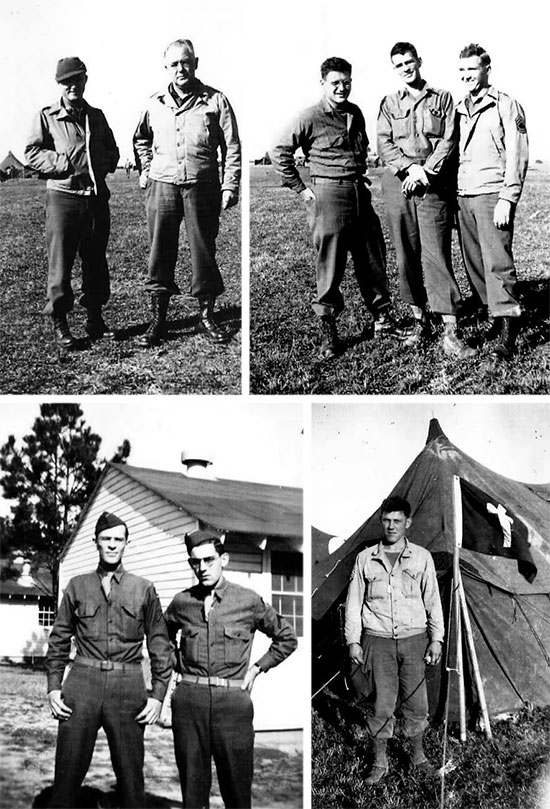
1943 pictures of 4th Convalescent Hospital staff and personnel while staying at Camp McPherson. Top Left; from L to R: Captain J. Howell and Captain D. Waller. Top Right; from L to R: Enlisted Men Private Bryson, Private First Class R. K. Sellers, Technical Sergeant Jim Durbin. Bottom Left;, from L to R: Private Eddie Mengerink and Private First Class Ralph K. Sellers. Bottom Right: Private Powell standing in front of the Chaplain’s tent.
United Kingdom:
The unit departed from New York P/E, 9 October 1943, with almost its complete T/O and TAT equipment, without having seen the complete unit assemblage for a Convalescent Hospital. Upon arrival in the United Kingdom, 16 October 1943, the organization was assigned to the Western Base Section, Services of Supply, European Theater of Operations, in England, and opened a 500-bed Hospital at Bromsgrove, handling overflow from a nearby General Hospital. After one month, the 4th moved to a previously unoccupied 750-bed hospital and immediately opened and operated such medical facility for mild Neuro-Psychiatric and Exhaustion cases not requiring guards or “locked door” care.
The training received in the Zone of Interior proved to be most valuable when the unit was assigned to the First United States Army (25 December 1943 –ed) and later functioned throughout the Normandy, Northern France, and subsequent Campaigns.
The guiding principle (based upon instructions from First US Army Surgeon –ed) was that the 4th Conv Hosp would operate as a “Detention Section” for treating all sulfonamide-resistant cases of Gonorrhea developing in the Army Area with Penicillin, and also all primary, secondary, or latent Syphillis developing in the Army Area would receive the most recent Penicillin treatment rather than arsenicals. To meet these professional requirements, Captain James M. Howell, MC, was transferred from SOS, ETO, to FUSA in anticipation, and immediately appointed Chief of Detention Service (later designated as Venereal Disease Section).
Furthermore information was received as to the possibility and probability of operating in echelons or sections, separated by miles of difficult communication. Therefore, the unit’s staff was split for such purposes along tentative lines of the CO with one echelon, and the XO with the second echelon, with all activities including Professional – Supply – Messing – Administrative showing similar coverage. Such plan was widely used during operations in France, Belgium, and Holland.
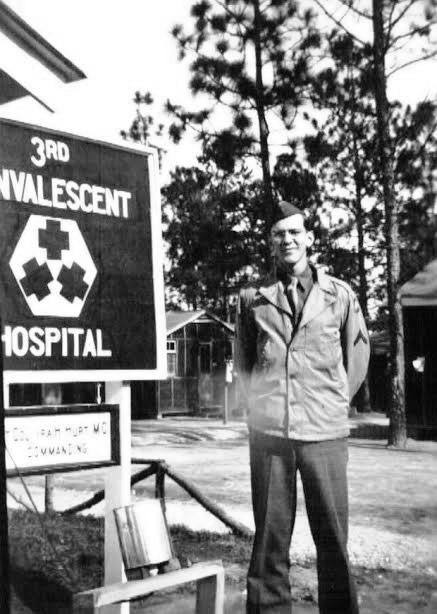
Picture of Private First Class Ralph K. Sellers at Camp Livingston, Alexandria, Louisiana (AGF Training Station and Reception Center where the 3d Convalescent Hospital was stationed, please see signpost). Pfc Sellers entered into active service at Camp Perry, Ohio, 22 September 1942, from where he was most probably transferred to Camp Livingston as a member of the cadre which helped form and increase the newly-activated 4th Convalescent Hospital. Picture taken in 1943.
By 1 January 1944 the Hospital was billeted at Bromsgrove, England. The unit was housed in an English Club and nearby Nissen huts. In anticipation of its future mission in the ETO, efforts were concentrated on the continuation of training programs, and on the procurement, assembly, and packing of equipment, supplies and other materials. Several changes of station took place while in England. By 20 January, the organization was in billets at Cookham, England, where it remained until departure for embarkation for France. The necessary equipment and medical supplies were requisitioned, obtained, grouped, and packed between 20 January and 20 June 1944. In accordance with orders from The Surgeon, First United States Army, the 4th moved from Cookham, England, by train to its Marshaling Area near Southampton. Upon arrival (20 June 1944 –ed) the unit was split for the cross-channel journey and on 23 June 1944, Detachment “A” (forward echelon) consisting of 23 Officers, 108 EM, and 8 ARC workers embarked at Southampton, for Normandy, France. Detachment “B” (rear echelon) consisting of 9 Officers and 80 EM traveled to the Marshaling Area using the unit’s organic transportation.
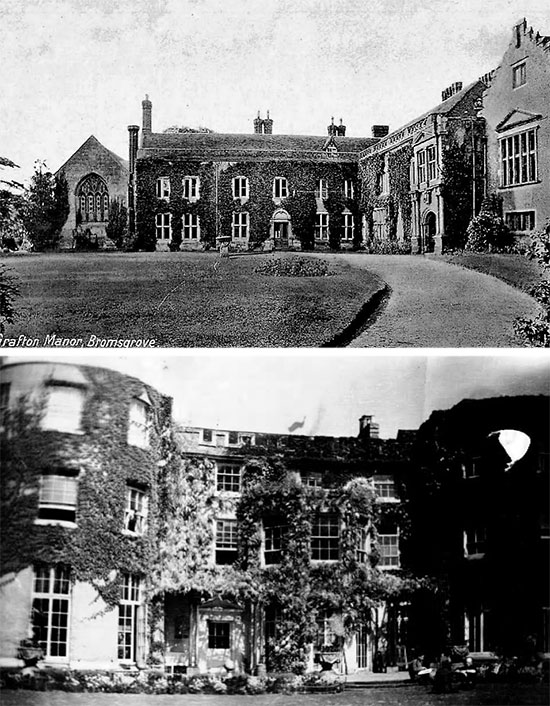
Top: Picture illustrating Grafton Manor, England, where the unit opened a 500-bed hospital plant for treating Neuro-Psychiatric and Exhaustion cases. The 4th Convalescent Hospital remained in Bromsgrove from October 1943 to January 1944. Bottom: View of Cookham Estate, England, where the organization operated from January 1944 to June 1944.
Transfer to the Continent:
On 22 June 1944, the entire Command of the 4th Convalescent Hospital consisting of 32 Officers and 188 Enlisted Men, were assembled in the Marshaling Area, awaiting Movement Orders to proceed to their overseas destination. The forward echelon embarked at Southampton, England, on 23 June, arriving at Omaha Beach, at 1400 hours, 24 June 1944. Following a single night bivouac in Transit Area “H”, Detachment “A” moved to La Cambe, France, in a field already occupied by another Hospital unit. Immediately after arrival, the necessary action was taken to locate the equipment that was to have arrived prior to debarkation of the advance group. After two days of intensive search through various Medical and Quartermaster Supply Dumps, only a portion of the equipment was found. Pilferage was not too great, except in the rations’ supply. Initially, the organization was issued a Hospital Supplement of rations for a three-day supply (or 9,000 rations), and it was discovered that approximately 7,000 rations had been pilfered or lost on the beaches. A guard was placed in the area of the unit’s stores and by expeditious transfer of the supplies to the Hospital’s site, further losses were held to a minimum. On 26 and 27 June 1944, unit equipment and supplies were collected at a Beach Depot near Isigny, and with the help of transportation provided by The Surgeon, FUSA, were moved to La Cambe. The field selected for the site had been cleared of mines by Army Engineers and the Hospital was set up and ready for operation with a bed capacity of 200. The 4th Convalescent Hospital (code name “Meander 4”-ed) was officially activated at 1800, 28 June 1944. The first patients were received 1 July 1944.
Detachment “B” with the balance of Officers and EM reached La Cambe on 1 July 1944, and arrived at the Hospital two days later. Meanwhile the overall capacity of the Hospital was increased by 200 beds each day until a total of 3,000 beds were set up for patients. On 24 July 1944, the medical installation’s census was 2,363 patients.
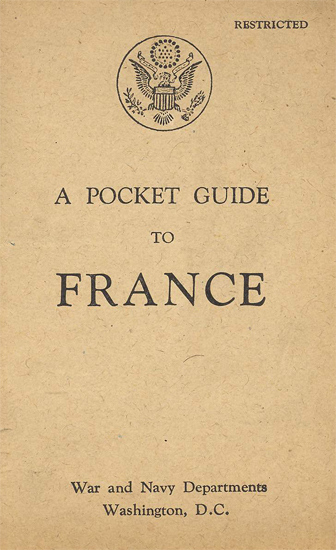
Early issue of “A Pocket Guide to FRANCE” (36 pages), issued by the War and Navy Departments, Washington, D.C., U.S.A.
Upon arrival in France the unit was immediately faced with a change or at least an addition in its mission, namely the hospitalization of patients with Self-Inflicted-Wounds (SIW), while awaiting findings of the Investigation Officer as to their LOD status, i.e. the question of intent to avoid hazardous duty, etc. Since most wounds involved the feet and hands and were rather severe (with compound fractures), the patient was not ambulant or just slightly so, depending on weather, terrain, and circumstances, and in view of the number reaching over 700 prior to establishment of LOD status (Line of Duty determination was initiated when a member of the military, whether hospitalized or not, had an injury or a disease resulting in; the inability to perform military duties; the likelihood of a permanent disability; the death of a member of the military –ed), a most difficult problem arose and many personnel, Officer and Enlisted worked daily for 16 to 18 hours throughout the month of July and even part of August.
Not only was the Hospital confronted with a mission foreign to that was contemplated, the type of patient was entirely different and the problems of general utilities (such as water and laundry) were greater than those anticipated. The understrength of the unit was proven, but with the temporary help of 10 Medical Officers, 20 Nurses, and 100 Enlisted Men of a General Hospital, the organization was able to accomplish its difficult mission. The disadvantage in obtaining help from an outside source, was in having to familiarize the attached people with the administrative procedures of the Hospital.
Furthermore, certain Evacuation Hospitals were prone to transfer bed patients with measles, mumps, meningitis, scarlet fever, and suffering from severe wounds to the Convalescent Hospital. With time and change in policy, the 4th Conv Hosp arrived at the prescribed mission, “10-day cases” (patients to be fit within 10 days –ed), ambulant, and requiring minimum definitive care. Such policy was a must in view of the limited Commissioned and Enlisted personnel, and the lack of Nurses. The inadequacy of a strength of 31 Officers and 192 EM to operate a 3,000-bed Hospital under extreme field conditions was clearly demonstrated. The problem was partially resolved by augmenting personnel by many temporary means, including unassigned Field Hospitals, Medical Collecting Companies, Detached Service and Temporary Duty of certain personnel.
Civilian personnel were not allocated until fall of 1944, when the organization occupied buildings for the first time in campaign. Such personnel were then used for manual and non-medical tasks, including cleaners, janitors, plumbers, and electricians when available, with skilled positions usually remaining unfilled.
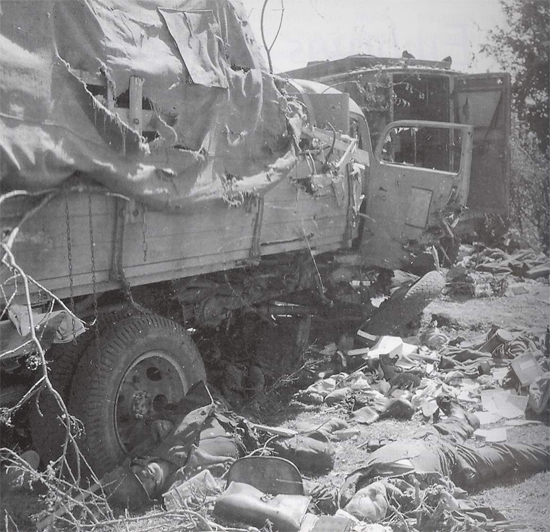
Normandy, France, summer of 1944. Death and destruction for the enemy …
It must be remarked that the 4th Convalescent Hospital lacked the necessary unit assemblage equipment for type Convalescent Hospitals (not available in England). British and American parts were often interchanged or mixed, causing considerable loss of time. The unit was given a low priority on equipment, but luckily some functional items were received, a number of Ward tents were substituted for Pyramidal ones, and additional water trucks and trailers were issued (though vehicles were always in demand and required for every change of hospital station). Waterproof chest were never issued and had to be constructed for the movement to France; heating units were improvised; any equipment not in use was carefully salvaged and reused many times; and general utilities such as mess tables, benches, tent pegs, poles, and latrine boxes were all constructed by the organization’s personnel.
Housing was under tentage. During field operations, Ward tents were used for the many patients, Pyramidal tents for the Officers, and individual Pup tents for the Enlisted Men, and this lasted from 28 June to 29 September 1944 inclusive (until the change in weather warranted the use of buildings).
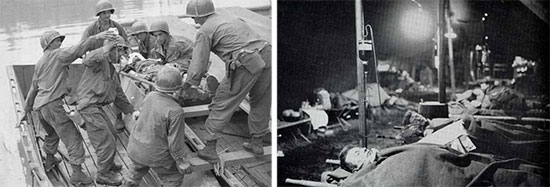
Left: Medical Detachment personnel evacuating a litter patient by small boat across a river.
Right: View of a shock ward inside a Hospital Ward tent.
As US forces expanded beyond their planned strength of 3 Army Corps, the Theater Command reinforced the First United States Army with 1 Field and 11 Evacuation Hospitals temporarily transferred from TUSA and intended to revert to that Army when it finally went into operation (1 August 1944 –ed). All additional units deployed between 28 June and 1 August 1944.
In August 1944 the unit received instructions to relocate in the vicinity of St. Lô, France, in order to establish a Convalescent Hospital of 1,500 beds. Since the Hospital had at this time approximately 1,400 patients, it was decided to split it into 2 echelons. The forward echelon (Det “A”) would open near St. Lô, while the rear echelon (Det “B”) remaining at La Cambe would be closed for reception of patients. This plan was followed throughout the Normandy and Northern France campaigns whenever necessary, and the system of “leap frogging” was found to be very satisfactory.
Detachment “A” set up 1,500 beds and began to receive patients. During this period, it became more and more difficult to return patients to duty. Higher headquarters instructed units and Replacement Depots to send vehicles to the hospital for members of their command, but due to the rapidly moving tactical situation the plan did not function and the 4th was forced to send out daily trucks to Divisions and Corps with soldiers ready for duty. Many men were even lost to proper Army units during their stay at some Replacement Depot. Because of such difficulties, 129 patients were transferred from the rear echelon (still at La Cambe) to the forward echelon at St. Lô on 14 August, enabling Det “B” to rejoin Det “A” the same day.

Somewhere in Belgium. Medical personnel help patients into a 3/4-ton Ambulance for evacuation to an Army Hospital in the rear.
Due to limited manpower, the 4th Convalescent Hospital received extra personnel from other medical units. During July 1944, personnel of the 16th Field Hospital including Officers, Nurses, and EM were attached to assist in caring for a large number of self-inflicted-wounds cases, on 30 July 1944, 30 Officers and Nurses and 98 Enlisted Men of the 30th General Hospital were attached for temporary service with the unit (they were withdrawn 14 August –ed). Between 13 October 1944 and 1 January 1945, 5 Officers and 96 EM of the 423d Medical Collecting Company were supplemented to the 4th.
At the peak of the dental load (July-August 1944), 18 Officers and 25 Enlisted personnel were attached to the unit. Another method to conserve manpower was to use convalescent patients for administrative and housekeeping duties.
On 15 August 1944, and in accordance with orders from The Surgeon, FUSA, a 500-bed Convalescent Hospital was set up in the vicinity of Gathemo, France. On 18 August, Det “A” jumped Det “B” and was activated, and six days later, the two units were again preparing for another leap frog. Per instructions, the Detachment operating at St. Lô was closed and the equipment moved to Gathemo. Final disposition of patients resulted in the transfer of approximately 300 patients from the rear to the forward echelon.
On 26 August 1944, orders were received to send a convoy with all necessary equipment and personnel to set up a 500-bed section of the Hospital in the vicinity of La Ville-aux-Nonains, near Senonches, France. The convoy consisted of 25 Officers and 120 Enlisted Men. It opened for patients on 29 August.
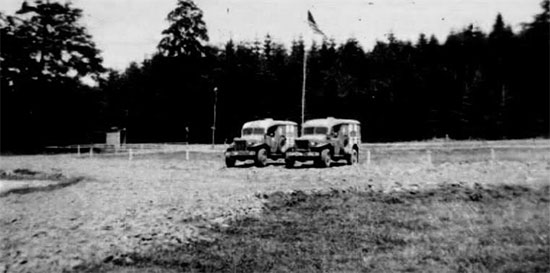
Picture illustrating two 3/4-ton WC-54 ambulances at the parking lot of the 4th Convalescent Hospital’s medical facility locateted at Neercanne, near Maastricht, Holland. Picture taken in October of 1944.
Water supply was from prescribed water points operated by the Corps of Engineers. Bathing facilities were most valuable with thousands of patients residing at the hospital. In the field 2 twelve-head showers were used for both patients and personnel. Laundry service was adequate, with hospital linen being transported to a nearby Evacuation Hospital having an attached QMC Laundry Platoon. For a few weeks, early in the campaign, the unit was fortunate in having such a laundry unit temporarily attached. With food and messing being most important in such a large hospital, 50 qualified cooks were available within the unit proper. Rations and Hospital Supplements were entirely satisfactory and no cases of caloric or vitamin deficiencies were known. It is of interest to note that early in the Northern France campaign, some incidents of broken dentures resulted from K–Ration biscuits.
Sewerage and waste disposal caused no problems. In the field, deep pit latrines were used and it was fortunate that the water level was below eight feet in most places. Unfortunately the hard clay in France absorbed little if any fluids and pits had soon to be closed. While insects did not really offer problems, prevention and issue of louse powder and fly traps, were always of great value. The presence of yellow jacket bees around mess lines and kitchens apparently hungry for sweets, resulted in several stings to personnel. VD control was one of constant education, including frequent lectures, 24-hour availability of dispensary prophylaxis and offering of individual pro-kits to men taking passes. The rate was below the general average of the Army. Few if any cases developed, but following rest periods, trips to Paris, and excursions, the rate usually jumped. The unit was not in operation proximate to known brothels and the like.
The Dental service in France was augmented about 300% by Dental Trucks, and TD personnel. Nevertheless, many military personnel arrived in France needing dental service.
Welfare of duty personnel and the tremendous number of ever changing patients was properly handled by a very active Special Service section (causing additional duty) and attached female workers of the American Red Cross. Movie shows were changed daily (with three showings), and day rooms, craft room, reading and writing rooms were always available, be it in tents, hallways, or buildings.
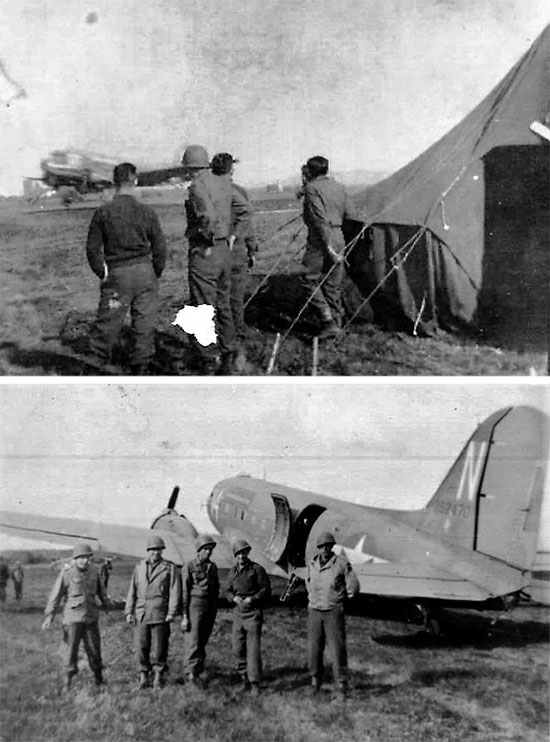
Top: Picture taken at the Advance Landing Ground (unidentified) from where as many as 120 C-47 cargo planes took off with the 4th Convalescent Hospital personnel and equipment for their move to Arolsen, Germany. Bottom: Another view of the same airstrip. In March 1945, the Hospital moved to Arolsen, by way of a motor convoy and by air transportation covering a distance of 200 miles.
On 7 September 1944, at 2400 hours, Detachment “B” closed for admission, at its station ½ mile north of Gathemo, France and was confronted with the problem of returning the balance of its patients to duty. The patients were therefore transferred to the forward echelon, Detachment “A” at Senonches, France, ½ mile east of La Ville-aux-Nonains.
In general, the 4th Convalescent Hospital did not see severe battle casualties, only early in the campaign. The prescribed plan of Penicillin, Sulfa preparations, local and oral, Plasma and Blood were closely followed. Blood was obtained from the nearby Evacuation Hospital.
| Registrar Statistics – 29 June 1944 – 31 August 1944 (France) | |
|---|---|
| Number of Patients admitted | 14,477 |
| Number of Patients evacuated and transferred | 10,292 |
| Number of Patients sent to duty | 3,802 |
| Number of Patients AWOL | 111 |
| Daily Average – Patient Strength | 1,250 |
| Admission, High, One (1) Day | 488 |
| Disposition, High, One (1) Day | 573 |
| Total Patient Days, for Period | 101,567 |
Problems encountered with Patients:
No actual difficulty in the evacuation of patients to other hospitals installations occurred. However, it was apparent that the type of patient sent to the 4th Conv Hosp was not the kind that should have been received. A Convalescent Hospital’s primary mission is to return patients to duty but only 27% were the duty type patient. A careful triage of cases did not take place. During July and August 1944, the organization received double amputations, serious injuries, severe battle casualties, self inflicted wounds, meningitis, scarlet fever, malaria, mumps, and other contagious diseases. Although every patient in the hospital was supposed to be ambulatory, at one time 574 litter cases were present. With approximately 73% of all patients received at this hospital being evacuated to other medical installations, it was apparent that unnecessary use of ambulances and other transportation occurred.
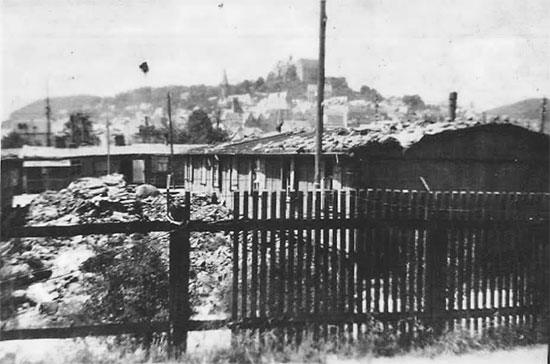
Partial view of Displaced Persons camp at Marburg, Germany. Picture taken in April-March 1945.
The most difficult problem was the return of patients to duty. Until the latter part of August 1944, no organized method for disposition was available. Lack of a place to send fit men, transportation difficulties, absence of coordinated plans by the Replacement system resulted in the following situations: at one time 1,100 men were ready for duty, but no place existed to send them to, and no transportation to a distant Replacement Depot was available. Many patients therefore went AWOL. The morale of troops dropped greatly when they could not return to duty to their unit. Hospital beds were filled with men ready to be returned to duty with combat units. Many men were re-hospitalized for injuries sustained while waiting to be returned to duty.
All Hospital units were authorized a stock of 50 complete uniforms to patients (including basic equipment, such as pistol belts, first aid packets, canteens, etc). The 4th had to issue up to 450 sets on a daily basis, meaning that over 1,000 sets of clothing and equipment had to be stocked (FUSA authorization was received). Existing T/BA did not authorize enough equipment to permit a Convalescent Hospital to operate properly. Transportation was inadequate, and supply became difficult when operating at full capacity, because of the lack of vehicles for transportation of food, water, gasoline, etc. POL products however, were easily obtained, except during the latter part of August 1944, when gasoline was almost non-existent in the unit’s area, unless destined for extremely high priority trips. Lumber and construction were available, with most of it being captured enemy material.
Belgium:
After closure of the installation at Senonches, France, First United States Army instructed Det “A” to move to Eupen, in the eastern part of Belgium. On 19 September 1944 the unit supplies and personnel were moved by train and motor convoy. There was however a change in location, and after seeing the Jesuit Seminary School building in Maastricht (at Neercanne, near the Dutch-Belgian border), Holland, the 1,500-bed Hospital set up in the available building, opening on 2 October 1944 for patients. The rear echelon (Det “B”) joined the forward echelon at the same location 16 October. The period was rather short as another move was ordered. The Hospital moved once more by echelons, regrouping at Spa, Belgium (in Belgian military barracks –ed), receiving its first patients on 26 October 1944. The 4th would function there until 18 December, when due to nearby enemy activity it was ordered to evacuate the location at Spa and move on to the town of Huy in Belgium.
Civilian personnel (about 20 people) were employed at Maastricht and at Spa for general housekeeping.
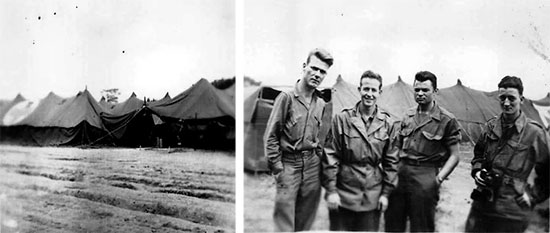
Left: Partial view of the 4th Convalescent Hospital bivouac at Gießen, Germany showing the mess hall tent. Right: Some Enlisted personnel during their stay at Gießen, Germany. Right, from L to R: Paul Crawford, George Jaminson, ‘Firing Pin’, and Junior Armstrong. Pictures taken in June of 1945.
On 17 December 1944, the westward drive of the German counteroffensive (code name: Wacht am Rhein –ed) compelled a series of withdrawals. The 44th and 67th Evacuation Hospitals, the 618th Medical Clearing Company Exhaustion Center, and the second advance section of the 1st Medical Depot Company, all retreated in haste from Malmédy toward Spa. On the same date, the unit was faced with the housing and feeding of the entire personnel of 2 Evacuation Hospitals on but two hours notice. By 18 December, enemy elements reached Stavelot, less than 10 miles from Spa, and as few American forces stood between the Germans and FUSA Headquarters located in Spa, the Army directed all logistical and medical installations to withdraw to Huy, Belgium. At the same time, FUSA moved to the vicinity of Liège, Belgium. The additional withdrawal involved a number of medical units, including the 134th Medical Group, the 57th Medical Battalion, and the 4th Convalescent Hospital (the 4th handled a record 1800 cases that same day, returning 900 patients to duty, evacuating another 300, and recording 600 patients). Since the beginning of the German breakthrough, the large installation of the 4th besides performing its main mission of patients’ reconditioning had housed and fed personnel of several retreating medical units. Within less than 24 hours, the Hospital disposed of its 1,400 patients, either returning them to duty, or transferring them to ComZ medical facilities. The staff then packed up their essential records and housekeeping equipment and took the road to Huy. At first, the organization bivouacked at Huy (18 December) and later at Tirlemont (29 December), since it could not resume operation for lack of a suitable site. Because of the large number of units in the area, free buildings were located with difficulty. Three buildings were located in Dinant, Belgium, with the Meuse River separating the larger from the other two. Adaptations were necessary, and the unit was therefore split up. One of the smaller buildings was used for administration and billets for one of the Detachments; the other building received all clinical or new patients; and the larger building across the river was used for convalescent patients, re-equipping, return to duty, disposition, etc. Within three weeks over 2,000 patients passed through the facility. The removal of the 4th Conv Hosp was a crippling blow to the entire FUSA hospitalization and evacuation system!

Left: Picture of Private Francis Felke, taken during the Hospital’s stay in Maastricht Holland, early October 1944. Right: Picture of Sergeant Ralph K. Sellers, in Maastricht, Holland, during winter.
In December 1944 (severe winter –ed) a new type of patient appeared in the Surgical Service, namely cases of “Trench Foot”. In general triage was excellent prior to arrival at the Hospital, but small areas of tenderness and spots of redness or skin discoloration were evident. Since all patients had to be ambulatory, and little definitive care was needed, shoes were sometimes refitted and most times required one size larger. Foot exercises were gradual and graded cases unfit for full field duty at the end of 10 days were then evacuated to General Hospitals. On an average about 500 Trench Foot cases were constantly within the Hospital during a six weeks period.
Well over half of the First Army’s Evacuation Hospitals that closed for movement had also lost their equipment, or had become inaccessible to the majority of Divisions fighting the German advance. In addition, the displacement of the 4th, the 618th Medical Clearing Company, and the 91st Medical Gas Treatment Battalion Communicable Disease facility left the Army unable to retain and care for short-term cases (most bypassed patients were therefore directed to the recently well-developed cluster of General Hospitals around Liège, which helped save the First United States Army medical services during the period). The 4th Conv Hosp remained in Tirlemont as of 1 January 1945 (in billets), awaiting further instructions…
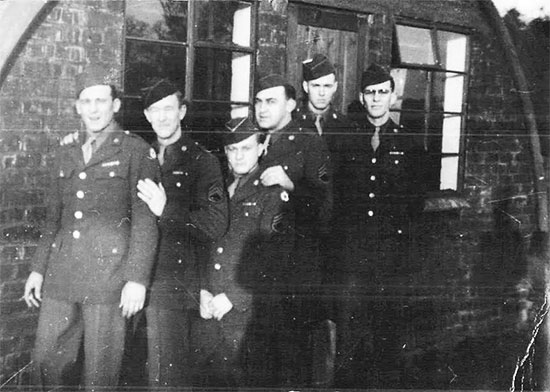
Picture illustrating some Enlisted Men of the 4th Convalescent Hospital, standing in front of a Nissen hut (location unknown). It appears to have been taken later during the war, as the men’s uniform coats are adorned with medal ribbons … the building seems reminiscent of the ones constructed in the United Kingdom … From L to R: Nick DeBerdanint, Grady White, Bill Pointer, Herb Singertot, Murl Skaggs, and Ralph K. Sellers.
Germany:
During winter, FUSA had evacuated all its patients to ComZ facilities during the heights of the Battle of the Bulge, but although faced with heavy personnel and equipment losses and inadequate replacements, had been quick to re-establish a convalescent capacity as the level of fighting dropped. As a result of this situation, the 4th Conv Hosp which was left far to the rear, was temporarily replaced by the 2d Evacuation Hospital, a Clearing Company, and the 91st Medical Gas Treatment Battalion, who inherited the task of holding the lightly-injured patients through brief periods of recovery within FUSA’s area, until the 4th could re-open in the Rhineland at Euskirchen on 22 March 1945.
The many small buildings had an inadequate bed capacity necessitating the use of tents for several hundreds of convalescent patients. Moreover, the area was low and very muddy during rain, so extra tents were pitched during dry weather with an expansion for bed capacity of several hundred. Such policy paid good dividends.
Following this period a long move was made to Arolsen, Germany. This involved moving by motor convoy over 200 miles and by air transport over 150 miles, because of the “Ruhr Pocket” which had to be avoided. 120 C-47 transport planes were used. A tremendous amount of packing, crating, and handling took place with help from some of the convalescent patients and German civilians employed by the organization. The movement was completed most satisfactory.
At the close of hostilities (April-May 1945), the unit received several hundred patients from another FUSA Hospital, freeing that particular unit’s personnel for use at Displaced Persons centers, RAMP installations and the like. Also the additional duties of a Station Hospital were taken on for all US troops over an area of 50 miles in diameter. The VD Chief and Technicians were placed on TD at an advance Medical Clearing Company, thereby reducing the transportation process for such type patients. With the taking on of the Station Hospital duties, 10 Nurses and 1 Auxiliary Surgical Team were attached and rendered excellent services for several weeks until the closing of the Hospital.
On 11 June 1945 the 4th was alerted for Redeployment, Direct, Category IIa, while yet open for patients. With closing of the Hospital, all patients were either returned to duty, or in a few cases, transferred to other Army medical units.
Redeployment offered a most peculiar problem: 90% of Commissioned personnel and 30% of Enlisted personnel were separated because of having over 85 points on the ASR index. The Replacements knew little or nothing of the function of a Convalescent Hospital. Having been overseas 22 months and under battlefield conditions since 24 June 1944, the morale of the unit fell to a new low with notification of Redeployment, Direct, and the CO considered this period as more difficult than the previous campaigns.
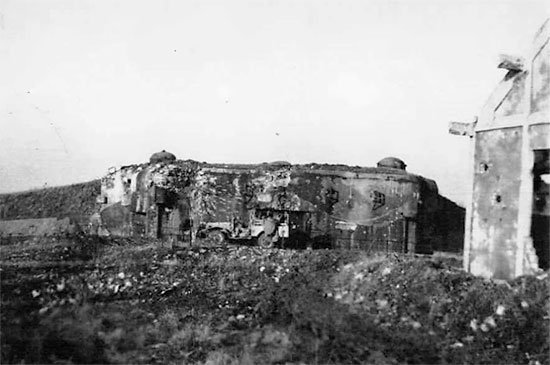
4th Convalescent Hospital Headquarters jeep near a German casemate, somewhere in Germany, around spring of 1945.
All equipment was to be inventoried, salvaged, or replaced as needed. A request was made for “waterproof” boxes to pack the surgical equipment and the like. In general, tents, motor, mess equipment, after a campaign of over one year are not in condition to warrant shipment to a distant Theater of Operations. Luckily, help was received from some of the Medical Depots. There was little time for training the Replacements as the packing and disposition of supplies and equipment along with necessary processing in the Assembly Area had priority. But en route and on arrival in the new Theater, some unit training would be necessary (a minimum of 3 months was recommended by the current CO, Colonel J. W. Claiborne, Jr.). Additional transportation was requested from The Surgeon (Provisional Truck Company, First United States Army Surgeon Section).
The remaining personnel of the 4th Convalescent Hospital left the European Theater on 8 October 1945 for return to the Zone of Interior and inactivation. The unit arrived home 18 November 1945 and following some preliminary administrative process the men of the command were returned to their respective Separation Centers for proper discharge.
Final recommendations:
Having operated a type Convalescent Hospital under all conditions it was believed that the following comments were in order. With reference to the Army Area, it would be better to have 2 units of 1,000 bed capacity each, with the present T/O of a 3,000-bed capacity for each, rather than the unwieldy and totally inadequate type of Hospital as currently organized, thereby doing away with the continual replacements and supplements in the form of Medical Collecting Companies, Medical Clearing Companies, or even Field Hospitals. The mission of this type of Hospital is proper and needed in the Army Area, and it is known that thousands of military personnel were saved in subject Area rather than additional loss in days through Replacement Depots, and deeper ComZ medical installations. It was also necessary to state that professional services were always improved when Army Nurses were available and a great strain was taken off the limited number of Enlisted Technicians. During its operational period, evacuation was satisfactory, but it should be recalled, that trucks had to be made available by the Army Surgeon, and properly the unit should have such trucking capacity as an organic part of equipment rather than subject to hourly recall, or replacement.

Staff Sergeant Ralph K. Sellers driving a German ‘booty’ car while stationed in Arolsen, Germany. Picture taken 4 June 1945.
Chronological journeys of the 4th Convalescent Hospital on the Continent (E.T.O.)
La Cambe, France – activated 28 June 1944
St. Lô, France
Gathemo, France
Senonches, France
Maastricht, Holland – operational 2 October 1944
Spa, Belgium – operational 26 October 1944
Huy, Belgium – bivouac, not operational 18 December 1944
Tirlemont, Belgium – not operational 29 December 1944
Dinant, Belgium
Euskirchen, Germany
Arolsen, Germany
Awards
14 Bronze Stars
2 Soldier’s Medals
1 French Croix de Guerre
Campaign Credits
Normandy
Northern France
Rhineland
Ardennes-Alsace
Central Europe
Change of Command
25 January 1943 – Lt. Colonel Edward S. Murphy, MC
25 May 1943 – Lt. Colonel John W. Claiborne, Jr., MC
22 October 1945 – Major Carl W. Hahn, MC
24 November 1945 – Captain Thomas P. Caito, MAC
The MRC Administrators are truly indebted to F. Lynn McNulty, who generously provided them with a copy of the official Unit History of the 4th Convalescent Hospital which operated in the European Theater during World War 2. Without his kind help, it would not have been possible to write and edit a concise History of this medical unit. Special thanks must also go to Linda Sellers-Foster, proud daughter of Staff Sergeant Ralph K. Sellers (ASN:35339385), who served with the 4th Convalescent Hospital in ETOUSA from October 17, 1943 to November 7, 1945. Linda provided the MRC Staff with a large number of period photographs related to her Father’s organization, which helped them illustrate the Hospital’s history. Thank you so much for your generous help.
